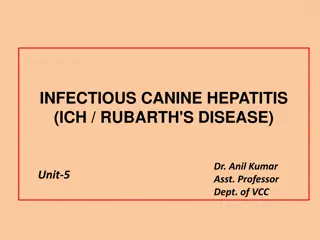Understanding Canine Monocytic Ehrlichiosis: Symptoms, Phases, and Treatment
Canine Monocytic Ehrlichiosis is a tick-borne disease caused by Erhlichia species, primarily affecting dogs. This article covers the pathogenesis, clinical findings in different phases (acute, subclinical, and chronic), and associated symptoms. Learn about the transmission, distribution, and potential outcomes of the disease.
Download Presentation

Please find below an Image/Link to download the presentation.
The content on the website is provided AS IS for your information and personal use only. It may not be sold, licensed, or shared on other websites without obtaining consent from the author. Download presentation by click this link. If you encounter any issues during the download, it is possible that the publisher has removed the file from their server.
E N D
Presentation Transcript
EHRLICHIOSIS Dr. Bipin Kumar Assistant Professor Department of Veterinary Medicine Bihar Veterinary College, Patna (Bihar Animal Sciences University, Patna)
Canine Monocytic Ehrlichiosis It is a tick borne disease caused by Erhlichia species. Dr Ehrlichia described this organism. Hence it was name as Erhlichia canis. Transmitted by the three-host tick Rhipicephalus sanguineus. Incubation period of 8 20 days. They are gram negative, pleomorphic coccobacilli rickettsia. Obligatory intracellular . Ecanis usually appears in monocytes as a cluster of organism called as MORULAE .
Experimentally it can also be transmitted by Dermacentor variabilis. Host for this disease is members of canidae family{fox , jackel , dog etc}. German shepherd dogs are most susceptible. It has world wide distribution including Asia ,Africa and America. Australia is free of E.Canis.
Pathogenesis Host get infection through tick bite E.canis enters into host and adhere to membrane of Monocytes Through endocytosis enters into the cell Divide by binary fission They form morulae Release of organism through rupture of morulae They spread to adjacent cells through cytoplasmic projections Spread throughout the body
Clinical findings There includes three phases :- Acute phase Persistence subclinical infection Severe chronic phase ACUTE PHASE. It is characterised by :- Upto 4 weeks , Fever, Severe Thrombocytopenia During this time the platelet count will drop due an immune-mediated platelet destruction . The dog will be listless, off food, and may have enlarged lymph nodes. Most dogs clear the organism if they are treated in this stage. But those that do not receive adequate treatment will go on to the next phase.
SUBCLINICAL PHASE: In this phase, the dog appears normal. The organism has sequestered in the spleen . Dogs can stay in this phase for months or even years. Intermittent fever ,mild Thrombocytopenia and anaemia. CHRONIC PHASE: Charecterised by :- Severe pancytopenia { due to bone marrow Hyperplasia}. Fever , wide spread petechia and edema. Death due to secondary bacterial infection .
There are no signs of the subclinical phase. Fever , Anorexia , lethargy ,weight loss. Epitaxis , Petechial haemorrage OCULAR SIGNS :- Retinal haemorrhage, Retinal detachment {due to Hyphema } Neurologic effects may also be seen.{due to meningeal bleeding} Glomeruloneprhitis, resulting in serious urinary protein loss, can also result. Increased globulin levels are also seen.
Diagnosis Clinical examination Hemotology and Serum biochemistry {Thrombocytopenia and Hypo albuminaemia and hyperglobulinaemia}. Dot ELISA kit @field level Molecular test PCR Serological test {FAT-flouroscent antibody technique }- which is widely used. Blood smear examination { to find MORULA in Monocytes}.
TREATMENT Doxycycline(5-10mg /kg/day) {PO/IV} for 21-25 days. OXYTETRACYCLIN ( 5-10 /Kg /day){I/V} for 21-25 days. Supportive therapy ( in anaemia ) Blood transfusion if Hb concentration is <4%. short term (2-7days)therapy with low immunosuppressive doses of Glucocorticoides {1-2mg /kg prednisolone, PO} This may be beneficial early in the treatment period when severe Thrombocytopenia is present.
Prevention Tick control is the most effective method of prevention. No vaccines are available. Chemoprophylaxis by using tetracyclin @6.6mg /kg .























